Bucharest
![]()
The title of this article is ambiguous. For a cargo ship named after this city, see Bucharest (ship).
Bucharest (Romanian: București [bukuˈreʃtʲ];![]() ) is the capital of Romania. It is the seventh largest city in the European Union, with a population of just over 1.8 million and an urban agglomeration of 2.2 million.
) is the capital of Romania. It is the seventh largest city in the European Union, with a population of just over 1.8 million and an urban agglomeration of 2.2 million.
After Bucharest finally replaced Târgoviște as the capital of the Principality of Wallachia in 1659, it became the political, economic and cultural centre of Wallachia and later of Romania. The city has several universities, various other colleges, as well as numerous theatres, museums and other cultural institutions.
The cosmopolitan high culture and the dominant French influence of the city's neo-Baroque architecture earned it the nickname Micul Paris ("Little Paris", also "Paris of the East"). During the reign of the Romanian dictator Nicolae Ceaușescu, large areas of the historic city were destroyed to make way for the monumental confectionery style of the head of state.

Dâmbovița
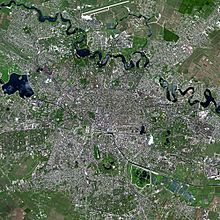
Satellite photo of Bucharest
Geography
Bucharest lies at 55 to 96.3 metres above sea level in the centre of the Wallachian Plain 68 kilometres north of the Danube and 280 kilometres west of the Black Sea. The city is crossed by the Dâmbovița River; its tributary, the Colentina, forms a chain of nine natural lakes to the north of the city.
Geology
The city is located south of the eastern Carpathian arc and the Vrancea zone between the Black Sea microplate and the Moesian plate, in one of the most earthquake-affected areas of Europe. Strong earthquakes pose a significant threat to the Romanian capital. Within the last 60 years, four strong earthquakes (10 November 1940, 4 March 1977, 30 August 1986 and 30 May 1990) have occurred beneath the so-called Vrancea region about 130 kilometres from Bucharest. Due to the very inhomogeneous subsurface structure, there is a fifty percent statistical probability of an earthquake of magnitude M = 7.6 within 50 years. Decisive for the seismic risk in Bucharest is the earthquake activity in the Vrancea zone in the eastern Carpathian arc, which is related to postorogenetic events at a Miocene subduction zone. The medium-depth earthquakes in this narrowly defined region are the cause of the sometimes catastrophic earthquake damage in Bucharest.
Climate
The climate is temperate continental. In the months of June, July and August, the average temperature is above 20 °C. Winter temperatures are often below 0 °C. However, they rarely fall below -10 °C. In January 1888, the lowest temperature was recorded in Bucharest at -30 °C, and on August 20, 1945, the highest temperature was recorded at 41.1 °C. Notorious in winter is the Crivăț, a cold continental wind blowing from the northeast, bringing permafrost and snowstorms.
| Monthly average temperatures and precipitation for Bucharest
Source: Administratia Nationala de Meteorologie (NMA) | ||||||||||||||||||||||||||||||||||||||||||||||||||||||||||||||||||||||||||||||||||||||||||||||||||||||||||||||||||||||||||||||||||||||||||||||||||||||||||||||||||||||||||||||||||||||||||||||||
The annual rainfall in Bucharest is 579 millimeters. The annual average temperature is 11.1 °C. The coldest month of the year is January, with an average low temperature of -5 °C. The hottest months are July and August, with an average maximum temperature of 27 °C.
City breakdown
Bucharest has a special administrative status in Romania and is not subject to any county administration. The city was divided into six administrative sectors (sectoare) in 1968, whose boundaries were redefined in the summer of 1979. The sectors and their districts are:
| Sectors | Districts |
| Sector 1 | Aviatorilor, Aviației, Băneasa, Bucureștii Noi, |
| Sector 2 | Colentina, Iancului, Pantelimon, Tei |
| Sector 3 | Balta Albă, Centru Civic, Dudești, Titan, Vitan |
| Sector 4 | Berceni, Olteniței, Timpuri Noi, Văcărești |
| Sector 5 | Cotroceni, Ferentari, Rahova |
| Sector 6 | Crângași, Drumul Taberei, Giulești, Militari |
Each of these sectors has a council with 27 seats, a town hall and a mayor. An expansion of the city area is planned. Those responsible are planning to incorporate the small town of Otopeni, which lies to the north of Bucharest.
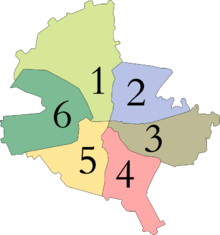
Sectors in Bucharest

Bucharest (red square) - Romania - Neighbouring places: Ploiești, Târgoviște, Giurgiu, Russe (Bulgaria), Silistra (Bulgaria)

Thunderstorm over Bucharest
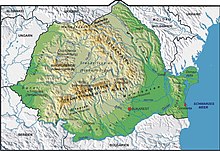
Location of Bucharest in Romania
History
→ Main article: History of Bucharest
According to legend, Bucharest was founded by a shepherd named Bucur. Bucurie in Romanian means happy joy, and Bucur is a common family name. In an etymological sense, București means you are happy. Another tale tells of the Getic king Dromichaites, who built Freudenstadt.
City foundation, residence of the princes of Wallachia
Bucharest is first mentioned in a document dated 20 September 1459. The document was issued by the voivode and general Vlad Țepeș, surnamed Drăculea.
In the second half of the 15th century, Bucharest, where an artisan settlement with a smithy, pottery and tannery can be traced as early as after 1400, developed into the curtea (princely seat) of Wallachia. Prince Radu the Beautiful designated Bucharest as a princely seat in a document on 14 October 1465. The city gained its central urban importance as a princely centre of power and trade, located in a congested area of settlements. Between 1459 and 1625, 41 settlements alone appear on the territory of present-day Bucharest.
Subsequently, Bucharest was the capital of Wallachia, alternating with Tîrgoviște. The main market was built around Lipscani Street.
Ottoman period
The Ottoman Empire expanded in the 14th century from Asia Minor to the territory of present-day Romania. As early as 1394, a first Ottoman army advanced across the Danube. After that, the principality of Wallachia became subject to tribute for the first time.
Under this Ottoman sovereignty, Bucharest, still a village, experienced an upswing due to the presence of the court as well as the return of foreign merchants. The population increased and an urban structure developed, expressed by a multitude of new buildings. In 1545, Prince Mircea Ciobanul built the first city wall in the form of a palisade rampart. Also, a large part of the agricultural land surrounding the town was now marked with boundary stones as "the land of the townspeople" (moșia orășenilor).
Thirty years later, the people of Bucharest rose up in 1574 and 1575, as well as in 1594, against the growing tributes of the High Gate. They also participated in the battles of Mihai Viteazul (Michael the Brave) against the Ottoman army, which were ultimately unsuccessful. After the latter fell away from the Ottomans, Grand Vizier Koca Sinan Pasha captured the city in August 1595 after the Battle of Călugăreni. This resulted in a city fire. In the autumn of the same year, another battle took place near Bucharest, during which the Turks retreated, destroying part of the city. For this reason, they subsequently moved the princely seat to Târgoviște until 1626. Shortly after taking power, Prince Alexandru Coconul moved the residence back to Bucharest on 10 November 1626.
After Prince Matei Basarab came to the throne in 1632 as the last of the predominant Wallachian family, he built numerous buildings in Bucharest. Because of his tense relationship with the Ottomans, the prince moved to Târgoviște around 1640. Meanwhile, the princely seat remained in Bucharest. Basarab's successor, Prince Constantin Șerban, moved again to Bucharest after taking office in May 1654. The following year, the Dorobantzes and infantrymen revolted against the boyars at the site of the present-day National Bank. On the occasion of the riots, Prince Șerban had the princely court and the city set on fire when he left for Târgoviște and moved the princely seat.
In 1659 there was another transfer of residence. After his enthronement, Prince Gheorghe Ghica moved the princely seat back to Bucharest on 20 December 1659. In the same year, under pressure from the Ottoman Empire, the city also became the sole residence city of the voivodes. From that year onwards, Bucharest remained the definitive capital of Wallachia. In 1668, the religious leadership of the Orthodox Church also followed the prince to Bucharest. During this period, the city population grew up to about 60,000 inhabitants, distributed in the meantime in 21 quarters (so-called mahalale). At that time there were about 100 churches. During the reigns of Șerban I Cantacuzino and Constantin Brâncoveanu, Bucharest experienced a prolonged flourishing. The first hospitals, printing houses, educational institutions, numerous churches, Mogoșoaia Castle and the Podul Mogoșoaia boulevard were built on the princes' instructions. However, the power-hungry Prince Brâncoveanu also abolished the mayor and town council and reserved the right to govern.
During the Phanariot period (1716-1821), the burden on the population of higher taxes and tributes, but also of nepotism and corruption, increased to such an extent that this period is regarded in Romania as the epitome of exploitation, corruption and mismanagement. In 1753, at the intervention of the people of Bucharest, Prince Matei Ghica was deposed by the High Gate because of unbearable tax burdens. Twelve years later, during the uprising of the guilds, Ștefan Racoviță met the same fate. Although the prince defeated the rebels, he was deposed by the High Gate because of the reprisals he had imposed.
The members of the princely family Ypsilantis, on the other hand, made visible contributions to Bucharest. During the reign of Alexander Ypsilantis, many improvements were made to the city and the first water conduit was built (1779). The prince also had a diversion canal built because of the frequent flooding of the Dâmbovița. At the same time, the first industrial development began in the town through manufactories. Thus, in 1764 a manufactory for wax was established, in 1766 one for clothes, in 1767 for paper. In 1811, 2,981 people were already working in trade and crafts.
During the Russo-Austrian Turkish War, this development was briefly interrupted when Prince Nicolae Mavrogheni fled the city on 26 October 1789, accompanied by an army of about a thousand men. The city was taken by the Austrians two weeks later on November 10, 1789, and was not surrendered until the peace of August 4, 1791. Subsequently, various natural disasters, a conflagration and epidemics struck the town between 1793 and 1812.
Transitional period (1807 to 1861)
In 1807, Bucharest came under the supreme command of the commander of the Russian troops during the Russo-Turkish War. The First Peace of Bucharest ended on 28 May 1812 the war between Russia and the Ottoman Empire that had been going on since 1806.
The intensified exploitation of the Wallachian masses and the spread of revolutionary ideas of the French bourgeoisie, as well as hetaerism, influenced anti-Ottoman public opinion at the turn of the century. During the ensuing uprising, the Wallachian leader Tudor Vladimirescu stayed in Bucharest from March to May 1821. This led to fierce reprisals by Turkish troops, who subsequently occupied Bucharest. These reprisals ended only with the withdrawal of the army in September 1822 and the accession of Prince Grigore IV. Ghica.
After the Peace of Adrianople in 1829, Bucharest was placed under Russian protection. From that year on, General Pavel Kiselyov administered the city until 1834. During his tenure, the Decree of Organic Regulation (Règlement organique) was introduced and a committee for the beautification of the city was convened. The boundaries of the city were redrawn. Other urban planning measures, such as the creation of promenades and market squares, were implemented.
A large fire in the commercial section of the city destroyed about 2,000 houses on March 23, 1847. The fire was followed by a planned reconstruction. The following year Bucharest was the centre of the Wallachian Revolution. The revolution, which began on June 11, 1848, was bloodily put down three months later on the evening of September 13 at Spirei Hill. A monument commemorates the event at this site. Between the years 1853 and 1856 Bucharest was occupied successively by Russian, Turkish and Austrian troops.
Bucharest was the first Romanian city to introduce petroleum lamps for street lighting, in May 1857. In the same year, by decree of the Sultan, the "Diwan Ad Hoc Assembly" met in Bucharest. The Assembly adopted a resolution on October 9, 1857, which, among other things, provided for the unification of Romania into one state.
Capital of Romania, industrialization until the First World War
Alexandru Ioan Cuza proclaimed the formation of the Principality of Romania from the Danubian principalities of Moldavia and Wallachia on 24 December 1861. One year later it came also formally to the union of the two principalities with Bucharest as capital. The state founder Alexandru Ioan Cuza came however into the criticism and had to resign therefore 1866. A provisional government appointed Karl Eitel Friedrich of Hohenzollern-Sigmaringen as prince on recommendation in the same year. After his official election as prince, he entered Bucharest as Carol I on 10 May 1866.
In 1869, the capital received its first railway line. It connected Bucharest with Giurgiu. Two years later, the first tramway line (then a horse-drawn tramway) was opened from the North Station via Piața St. George to Piața Obor. After four years of construction, the North Railway Station opened in 1872, as did the railway service between Bucharest and Ploiești.
After the Congress of Berlin, Romania was recognized as independent in 1878. Subsequently, on 26 March 1881, the principality proclaimed itself the Kingdom of Romania. Bucharest was thereby transformed into an imperial city. The young kingdom oriented itself towards the West, especially towards France. Prussia was the supplier of ideas and technology for the modernization that followed.
Towards the end of the 19th century, Bucharest then gradually developed into an industrial centre, especially in light industry. Five major banking institutions - including the National Bank, the Bank of Romania, the Agricultural Bank and, since 1898, the Discount Bank - made Bucharest the national financial centre. Electric light was introduced on Calea Victoriei in 1890. It was also at this time that the new arterial road from Obor to Cotroceni was opened. In 1896, the scheduled service of the first electric tram followed on the same route.
In 1886, the Peace of Bucharest ended the war between Serbia and Bulgaria. The Second Balkan War was also ended in the city in 1913 with the signing of the Bucharest Peace Treaty between Serbia, Greece and Romania on one side and Bulgaria on the other.
From the First to the Second World War
During the First World War, Bucharest was occupied by German troops from 6 December 1916 as a result of the Battle of Argesch until the peace treaty of 7 May 1918. With the flight of the king and the government, Iași became the provisional capital of Romania during this period. The importance of the city increased again only after the First World War as the capital of "Greater Romania".
From 1918 until the beginning of the Second World War, the city area increased by 5600 to 7800 hectares. The population increased from 380,000 to 870,000 in the same period. International interest was aroused by a strike of oil workers and railwaymen who had stopped work because of the worsening living conditions. On 16 February 1933, the strike at the Grivița Works was bloodily put down.
With the construction of the Piața Victoriei and Piața Sf. Gheorghe axis between 1936 and 1940, following the Parisian model of Boulevard Henri Martin and the Brussels design of Boulevard Louise, the city acquired the nickname "Paris of the East". The 1940s saw a continuation of brisk building activity in the Western style, but this time in a modern, international style, marked by names such as Le Corbusier or designations such as "form and function".
Bucharest during the Second World War
During the Second World War, Romania, after initial neutrality, joined the three-power pact between the German Empire, the Empire of Japan and the Kingdom of Italy on 23 November 1940. This was the direct result of the formation of the government of a "national-legionary state" on 4 September 1940 by the Iron Guard and General Ion Antonescu, and led to the abdication of Carol II in favour of his 19-year-old son Mihai. A month later, German troops crossed the Romanian border on October 8. Shortly thereafter, the Wehrmacht entered Bucharest. In January 1941, an attempted coup by the ultra-right Legionnaires of the Iron Guard against the totalitarian Antonescu government failed. During the three-day coup, the Iron Guard murdered at least 120 Bucharest Jews in a pogrom between January 21 and 23, most of them in a forest near Jilava.
From April 1944 Bucharest came within the range of the American and British air forces. On 4 April 1944, the first major attack was carried out by the 15th Air Force. 875 tons of bombs were dropped. The main railway station (Gara de Nord) was also bombed. Some of the bombs fell on residential areas due to strong winds. There were many civilian casualties. Casualty figures vary between 2000 and 5000 dead, with 2942 dead and 2126 injured as the official figure.
On April 15, another heavy attack by the British Royal Air Force followed, this time with incendiary bombs. The University of Bucharest was also severely damaged. Towards the end of the war, Romania, through a coup d'état by King Michael, allied itself with the Allies on August 23, 1944. Adolf Hitler ordered the bombing of Bucharest the same night, which was continued the following night. 182 people were killed. Many government buildings as well as historical buildings were damaged or destroyed. One day later Romania declared war on Germany. After the invasion of the Red Army in Bucharest on 31 August, it came to an armistice between Romania and the Soviet Union on 12 September 1944.
As a result of disputes in 1945 between the new Prime Minister Petru Groza and King Michael I, the latter refused to sign any laws, whereupon Groza decided to put the laws into force even without the royal signature. In this context, an anti-communist demonstration took place in front of the Royal Palace in Bucharest on November 8, 1945. The violent dispersal of the demonstration resulted in many arrests, injuries and deaths.
From the Second World War to the present
In the four decades after the Second World War, the city grew to more than double its population. Bucharest became a huge construction site, especially in the peripheral areas. The city area tripled to 21,700 hectares during this period. Farmers in particular were drawn to the city, finding their new jobs here in the large industrial plants. They brought their rural way of life with them to the megacity and still determine its image today. In order to be able to meet the strong demand for housing, the communist state leadership set in motion an extensive housing construction program.
The so-called Bucharest Declaration ("Declaration for the Guarantee of Peace and Security in Europe"), which was adopted by a Warsaw Pact conference held from 4 to 6 July 1966, attracted international attention.
On 4 March 1977, an earthquake shook the area around Bucharest. A total of over 1,500 people died. The tremors also destroyed parts of the historical building fabric. The clean-up work marked the beginning of a new phase in the city's development, characterized by a radical reconstruction of the inner city. For after the earthquake Nicolae Ceaușescu saw the possibility of replacing the traditional urban structure of large inner-city areas almost completely with a colossal political-administrative centre. In its place came new symbols of monumental demonstration of power. The core and dominating element is the Palace of Parliament, the construction of which employed some 20,000 workers. The city also received a functioning subway.
In mid-December 1989, the popular uprising against Nicolae Ceaușescu began in Timișoara. This reached Bucharest on 21 December because the Ceaușescu regime ordered a public rally in front of the Central Committee of the Romanian Communist Party to showcase its popular support following the unrest in Timișoara. However, the state-organized demonstration turned into the opposite. Securitate troops, snipers and army units equipped with tanks massacred the outraged crowd within a day. Fires broke out in the former royal palace and in the university library. A day later, on December 22, 1989, the state television station TVR announced Romania as liberated. In Bucharest alone, there were about 500 dead. After the uprising, it turned out that Bucharest had a number of bunker systems and tunnels, some dating back to the Middle Ages. For example, from the former building of the Central Committee, an escape tunnel leads from the Calea Victorei zone to the Universitate metro. In addition, the Palace of Parliament has a large bunker with various exits. A year later, protests again took place in University Square, directed against the election of Ion Iliescu as President of Romania. However, the demonstrations were violently dispersed ("Mineriades") by the miners from the Jiu Valley who were called in.
On 30/31 May 1990, two earthquakes of magnitude 6.7 and 6.0 respectively struck the city again. In 1995 Bucharest became the permanent seat of the SECI. At the end of the 1990s, Pope John Paul II visited the Romanian capital during his visit to Romania. At a celebration of reconciliation between the Orthodox and Catholic Churches, the Pope symbolically presented Patriarch Teoctist I with a substantial donation for the construction of the largest Orthodox cathedral at Piața Unirii in central Bucharest on 14 May 1999.
The intensive construction activity in the historic old town since the turn of the millennium is partly taking place at the expense of the historic building fabric. For many, the Cathedral Plaza office tower is a symbol of this conflict.
In 2006, the 11th Summit of the International Organization of Francophonie was held in Bucharest. In the year of Romania's accession to the EU, the fifth Patriarch Teoctist I died. Four days after his death, his funeral took place in the Patriarchal Church on 3 August 2007. In the period from 2 April to 4 April 2008, the city hosted the XX NATO Summit.
At the end of October 2015, a fire disaster occurred in Bucharest. It killed 64 people and injured 147, some of them seriously. The government then ordered three days of national mourning. On March 12, 2016, the Spring Palace was opened for general viewing for the first time "so that the people can make their peace with history," according to the Minister for Dialogue with Civil Society, Violeta Alexandru. The palace and garden were built in 1964/65 according to the ideas of Nicolae Ceausescu, who ruled from 1965 to 1989 and lived in the luxury residence with 80 rooms, cinema, pool and bunker for just as long with his wife and three children. After the coup, the palace was used to accommodate state guests.

View from the Palace of Parliament to Bulevardul Unirii, August 2012

Obor Square and Metro Station, September 2011

The railway station "Gara de Nord" during the bombing by the United States Army Air Forces on April 4, 1944.

Revolution, 1848

Earthquake 1977
.jpg)
Horse-drawn tramway, 1871

Boulevard Magheru in the interwar period
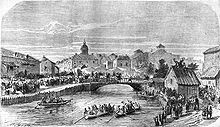
Entry of Prince Carol I, 1866
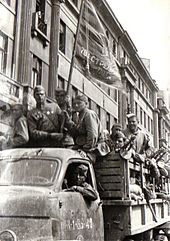
Red Army troops in Bucharest, 1944
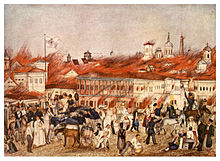
Town fire 1847

Surrender of the city to the Austrians, 1789
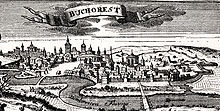
Bucharest 1717

Document of Prince Radu dated 14 October 1465 (facsimile)
Search within the encyclopedia